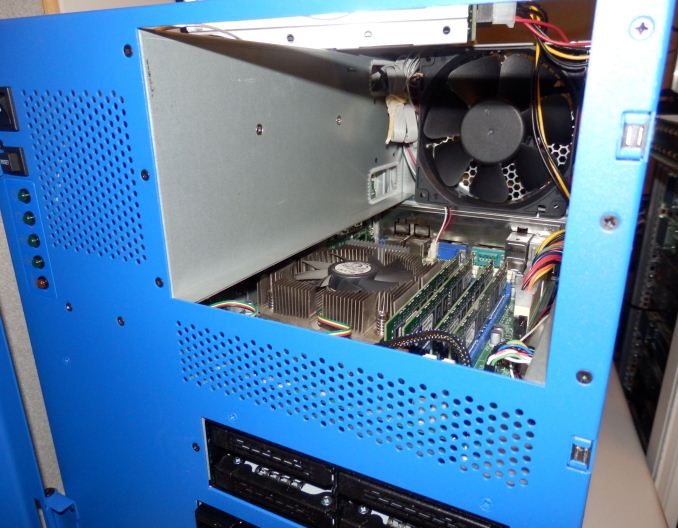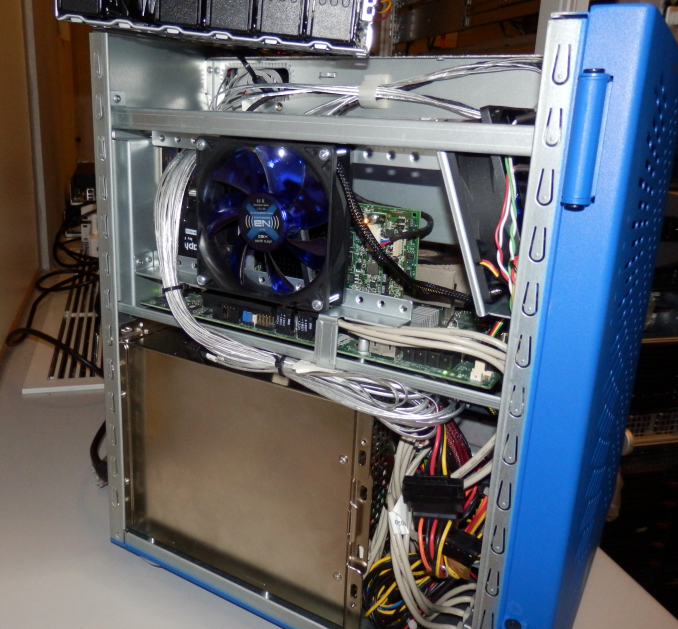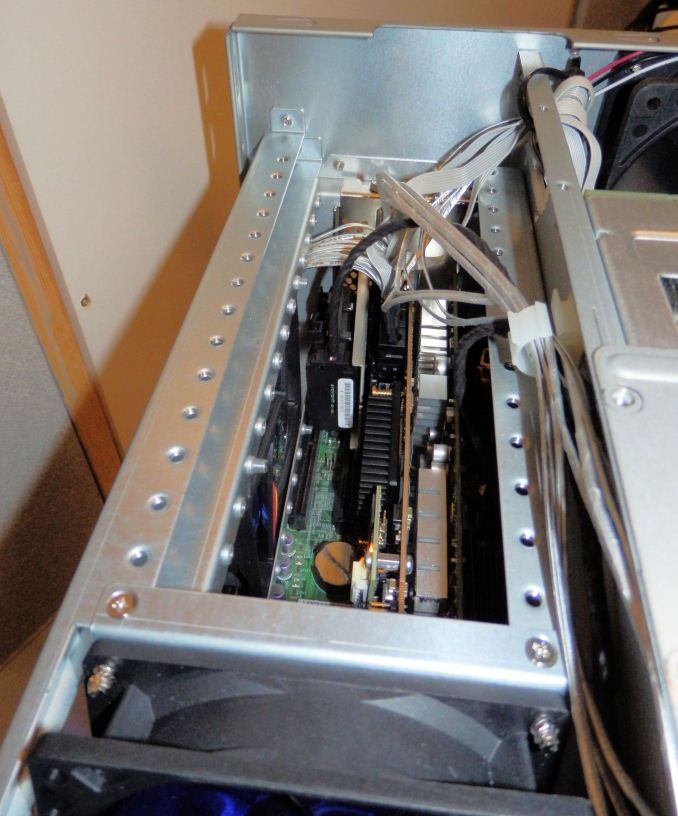Advatronix Cirrus 1200: a Storage Server Under Your Desk
by Johan De Gelas on June 6, 2014 5:00 AM ESTA Look Inside
Since the Advatronix Cirrus 1200 is a mix between a desktop and a server chassis, we felt we should investigate the internals a bit more closely than we would with a typical rack server. First, we removed the storage bays.
The Cirrus 1200 chassis consists mostly of the two drive modules with six 3.5" disk bays in each. A large 120mm keeps the drive bays cool but the large 3.5" drive bays obstruct the airflow over the motherboard and CPU heatsink. As a result, a fan on top of the CPU heatsink is necessary, which is not optimal if you want a highly available and easy to service server. A larger heatsink positioned next to the drive module and not under the module with cooling provided by the large and easy to replace fan at the back would make the Cirrus more "server grade".
The RAID card and optional 10G Ethernet card on the left are cooled by two fans. One fan blows from the front and one blows from the left.
The last fan seems to be there for redundancy reasons as the front fan is enough to cool the heatsink of the RAID card. The fans are easy enough to reach, but we would prefer easier and faster hot-pluggable fans that can be replaced without using a screwdriver.
Three PCIe slots are available, but the Battery Backup Unit of the Adaptec RAID controller covers the third PCIe slot. Considering the target market of the Cirrus 1200, that is hardly an issue. In total you can get two 10G Ethernet and two 1Gb Ethernet interfaces, which should be sufficient for the target market.













39 Comments
View All Comments
thomas-hrb - Friday, June 6, 2014 - link
If you looking at storage servers under the desk why not consider something like the DELL VRTX. that at least have a significant advantage in the scalability department. You can start small and re-dimension to many different use cases as you growJohanAnandtech - Friday, June 6, 2014 - link
Good suggestion, although the DELL VRTX is a bit higher in the (pricing) food chain than the servers I described in this article.DanNeely - Friday, June 6, 2014 - link
With room for 4 blades in the enclosure the VRTX is also significantly higher in terms of overall capability. Were you unable to find a server from someone else that was a close match in specifications to the Cirrus 1200? Even if it cost significantly more, I think at least one of comparison systems should've been picked for equivalent capability instead of equivalent pricing.jjeff1 - Friday, June 6, 2014 - link
I'm not sure who would want this server. If you have a large SQL database, you definitly need more memory and better reliability. Same thing if you have a large amount of business data.Dell, HP or IBM could all provide a better box with much better support options. This HP server supports 18 disk slots, 2 12 core CPUs, and 768GB memory.
http://www8.hp.com/us/en/products/proliant-servers...
It'll cost more, no doubt. But if you have a business that's generating TBs of data, you can afford it.
Jeff7181 - Sunday, June 8, 2014 - link
If you have a large SQL database, or any SQL database, you wouldn't run it on this box. This is a storage server, not a compute server.Gonemad - Friday, June 6, 2014 - link
I've seen U server racks on wheels, with a dark glass and keys locking it, but that was just an empty "wardrobe" where you would put your servers. It was small enough to be pushed around, but with enough real estate to hide a keyboard and monitor in there, like a hypervisor KVM solution. On the plus side, if you ever decided to upgrade, just plop your gear on a real rack unit. It felt less cumbersome than that huge metal box you showed there.Then again, a server that conforms to a rack shape is needed.
Kevin G - Friday, June 6, 2014 - link
Actually I have such a Gator case. It is sold as a portable case for AV hardware but conforms to standard 19" rack mount widths and hole mounts. There is one main gotcha with my unit: it does't provide as much depth as a full rack. I have to use shorter server cases and they tend to be a bit taller. It works out as the cooling systems of taller rack cases tend to be quieter and an advantage when bring them to other locations An more of a personal preference thing but I don't use sliding rails in a portable case as I don't see that as wise for a unit that's going to be frequently moved around and traveling.martixy - Friday, June 6, 2014 - link
Someone explain something to me please.So this is specifically low-power - 500W on spec. Let's say then that it's a non-low-power(e.g. twice - 1kW). I'm gonna assume we're threading on CRAC territory at that point. So why exactly? Why would a high powered gaming rig be able to easily handle that load, even under air cooling, but a server with the same power factor require special cooling equipment with fancy acronyms like CRAC?
alaricljs - Friday, June 6, 2014 - link
A gaming rig isn't going to be pushing that much wattage 24x7. A server is considered a constant load and proper AC calculations even go so far as to consider # of people expected in a room consistently, so a high wattage computer is definitely part of the equation.DanNeely - Friday, June 6, 2014 - link
I suspect it's mostly marketing BS. One box even a high power one that's at a constant 100% load doesn't need special cooling. A CRAC is needed when you've got a data center packed full of servers because they collectively put out enough heat to overwhelm general purpose AC units. (With the rise of virtualization many older data centers capacity has become a thermal limit instead of being limited by the number of racks there's room for.)At the margin they may be saying it was designed with enough cooling to keep temps reasonable in air on the warm side of room temperature instead of only when it's being blasted with chilled air. OTOH a number of companies that have experimented with running their data centers 10 or 20F hotter than traditional have found the cost savings from cooling didn't have any major impact on longevity so...